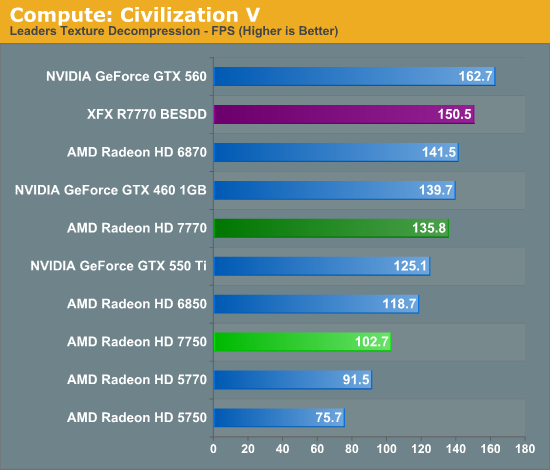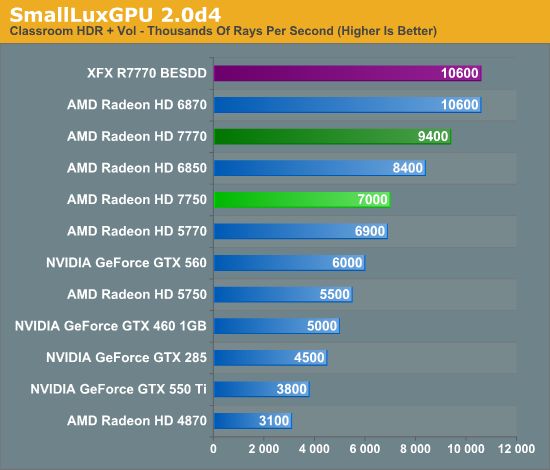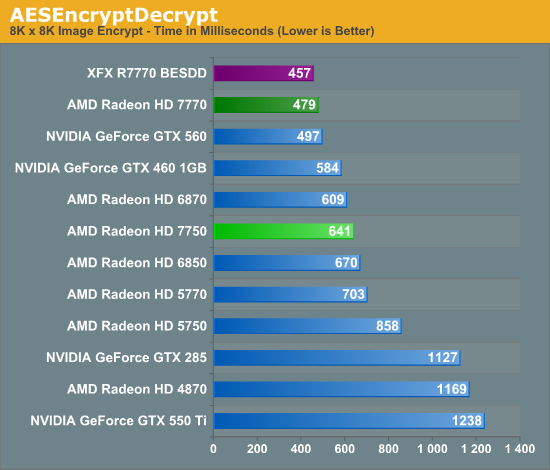AMD Radeon HD 7750 & Radeon HD 7770 GHz Edition Review: Evading The Price/Performance Curve
by Ryan Smith & Ganesh T S on February 15, 2012 12:01 AM EST- Posted in
- GPUs
- AMD
- HTPC
- GCN
- Radeon HD 7000
Compute Performance
Moving on from our look at gaming performance, we have our customary look at compute performance. With GCN AMD significantly overhauled their architecture in order to improve compute performance, as their long-run initiatives rely on GPU compute performance becoming far more important than it is today.
With such a move however AMD has to solve the chicken and the egg problem on their own, in this case by improving compute performance before there are really a large variety of applications ready to take advantage of it. As we’ll see AMD has certainly achieved that goal, but it raises the question of what was the tradeoff for that? We have some evidence that GCN is more efficient than VLIW5 on a per-shader basis even in games, but at the same time we can’t forget that AMD has gone from 800 SPs to 640 SPs in the move from Juniper to Cape Verde, in spite of a full node jump in fabrication technology. In the long run AMD will be better off, but I suspect we’re looking at that tradeoff today with the 7700 series.
Our first compute benchmark comes from Civilization V, which uses DirectCompute to decompress textures on the fly. Civ V includes a sub-benchmark that exclusively tests the speed of their texture decompression algorithm by repeatedly decompressing the textures required for one of the game’s leader scenes. Note that this is a DX11 DirectCompute benchmark.

Theoretically the 5770 has a 5% compute performance advantage over the 7770. In practice the 5770 doesn’t stand a chance. Even the much, much slower 7750 is ahead by 12%, meanwhile the 7770 is in a class of its own, competing with the likes of the 6870. The 7770 series still trails the GTX 560 to some degree, but once again we’re looking at the proof of just how much the GCN architecture has improved AMD’s compute performance.
Our next benchmark is SmallLuxGPU, the GPU ray tracing branch of the open source LuxRender renderer. We’re now using a development build from the version 2.0 branch, and we’ve moved on to a more complex scene that hopefully will provide a greater challenge to our GPUs.

SmallLuxGPU is another good showing for the GCN based 7700 series, with the 7770 once again moving well up the charts. This time it’s between the 6850 and 6870, and well, well ahead of the GTX 560 or any other NVIDIA video cards. Throwing in an overclock pushes things even farther, leading to the XFX BESDD tying the 6870 in this benchmark.
For our next benchmark we’re looking at AESEncryptDecrypt, an OpenCL AES encryption routine that AES encrypts/decrypts an 8K x 8K pixel square image file. The results of this benchmark are the average time to encrypt the image over a number of iterations of the AES cypher.

Under our AESEncryptDecrypt benchmark the 7770 does even better yet, this time taking the #2 spot and only losing to its overclocked self. PCIe 3.0 helps here, but as we’ve seen with the 7900 series there’s no replacement for a good compute architecture.
Finally, our last benchmark is once again looking at compute shader performance, this time through the Fluid simulation sample in the DirectX SDK. This program simulates the motion and interactions of a 16k particle fluid using a compute shader, with a choice of several different algorithms. In this case we’re using an (O)n^2 nearest neighbor method that is optimized by using shared memory to cache data.

It would appear we’ve saved the best for last, as in our fluid simulation benchmark the top three cards are all 7700 series cards. This benchmark strongly favors a well organized cache, leading to the 7700 series blowing past the 6800 series and never looking back. Even NVIDIA’s Fermi based video cards can’t keep up.










155 Comments
View All Comments
PatrickSteamboat - Wednesday, February 15, 2012 - link
Will there be any testing on Cape Verde's Crossfire scalability in the near future? I'm really interested to see if dual 7750s can fill the gap between it and the 6950. Unlocking a hidden, low power 6900 variant, the missing 6930, without having to match and compare more than three SKUs sounds too good to be true.Roland00Address - Wednesday, February 15, 2012 - link
7750s can't do crossfire since they do not have a crossfire bridge.7770s can do crossfire since they have a single crossfire bridge (can't do trifire though).
PatrickSteamboat - Thursday, February 16, 2012 - link
Can't believe I missed... anyways, thanks for that.
I found a preliminary benchmark with dual 7770s. Numbers look great so far, but at $318 for two, I'll be waiting until I can have both for less than $279. One now @MSRP, the second discounted once Kepler is out.
mczak - Thursday, February 16, 2012 - link
That isn't true. 7750 don't have a crossfire connector but they can do crossfire just fine, by transferring the data over the pcie bus.According to techpowerup benchmarks which tested that there's not even really a performance hit due to that (though they used a board with 2x16 pcie lanes, albeit only pcie 2.0, so should be similar to ivy bridge lga1155 which will have 2x8 pcie 3.0, and it might be worse on sandy bridge lga1155 which only has 2x8 pcie 2.0), though they say there were some stability issues, which certainly are driver fixable.
I usually question the viability of low-end CF setups however, I think you'd be far better off with one HD7800 card instead (you shouldn't need to wait that long for it after all).
Belard - Thursday, February 16, 2012 - link
Its been almost 4 years since the ATI 4850 was released. Within about 6~8 months of being on the market, it became a $100~110 card.The NEW 7750 is also a $100~110 and from looking at these reviews, it performs no better than a four year old gaming card that sold for $100.
Menoetios - Thursday, February 16, 2012 - link
Nvidia is as much to blame for the lack of shift in the price/performance curve as AMD. That's just the nature of competition. If you look at the 7770 and 7750 pricing compared to what Nvidia currently has available, it falls right in line. AMD doesn't care that you buy a 7770 or a 6850; with the former they'll make a nice margin, with the latter it'll help clear out the channel. They only care that you buy one of their products, and their products are priced just fine to that end. With only 123 mm2 die size (it's quite tiny), the 77** cards have a lot of room to get cheaper when Kepler is released. And I hope Kepler is REALLY good, because that's when we'll see the true price/performance shift.chizow - Thursday, February 16, 2012 - link
How so? Nvidia is not the one pricing their next-gen parts based on last-gen performance and pricing, AMD is. If Nvidia does that with Kepler, then you they share in equal blame. But AMD had the chance to fire the first salvo this generation and they whiffed, badly, on all 3 volleys now (7970, 7950 and now 7770).Menoetios - Thursday, February 16, 2012 - link
AMD have set their prices according to what's available on the market from Nvidia.chizow - Friday, February 17, 2012 - link
And that's exactly the problem! They're pricing new 28nm next-gen parts based on old 40nm last-gen price and performance levels. Nvidia's pricing was justified 14 months ago because the performance was there. It would not be satisfactory if they came out with a "new" part tomorrow and priced it the same as their old parts, would it?Blame lies squarely on AMD for this because they set the pricing on their parts and they were first to market. Look at it historically over the last 2-3 major generations, never once has Nvidia done this with a new architecture (not refresh) in terms of moving the performance bar so little while expecting the same top of the line premium pricing.
Hellbinder - Thursday, February 16, 2012 - link
Ok, Anand continues to amaze.. he/they are either dumber than a box of rocks or intentionally biased against AMD and simply looking for any excuse to skewer them. Personally i lean towards option number 1.The author of this review has completely buffooned the entire thing by getting the basic workings of AMD numbering & performance scaling WRONG.
yes the naming convention changed. but not in the way anand seems to think. This should be no brainier information for a site like this.
Top 7900 next 7800 next 7700 next 7500 next 7400 and so on.
The 6000 series was identical
Top 6800 next 6800 next 6700 next 6500 next 6400 and so on
the older models were different.
IF you want to compare apples to apples you compare the 6700 series to this series. The 6800 series is an entire tier above this card and should outperform it.
This site needs to get its crap together because nearly every other tech site makes this one look foolish, because they are foolish. or fire this reviewer and the editor and get some people who know what the hell they are talking about.